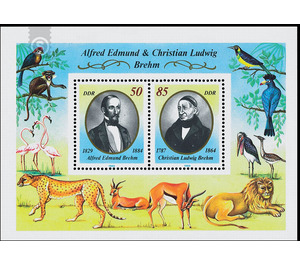Appreciation by Christian Ludwig and Alfred Edmund Brehm - Germany / German Democratic Republic 1989
Theme: Animals
| Country | Germany / German Democratic Republic |
| Issue Date | 1989 |
| Item Type | Block |
| Chronological Issue Number | 3201 |
| Chronological Chapter | GER-DDR |
| Michel ID | DDR BL98 |
| SID | 217182 |
| In 28 Wishlists | |
Appreciation of Christian Ludwig and Alfred Edmund Brehm On the occasion of the tribute of Christian Ludwig and Alfred Edmund Brehms, the Ministry of Postal and Telecommunications of the German Democratic Republic issues a multi-colored special postage stamp block. Special cancellation from June 13 to August 12, 1989 Appreciation Christian Ludwig and Alfred Edmund Brehm Christian Ludwig Brehm was born on January 24, 1787 in the village of Schönau in the forest near Gotha, the son of a pastor. After completing his studies in theology in Jena, he was initially tutor for two years on a manor. From 1813 until his death on June 23, 1864, he became village pastor for 51 years in the small silent Renthendorf near Neustadt (Orla). From childhood on he dealt with the bird world. Brehm was an excellent nature observer and at the same time a passionate and tireless hunter and bird catcher. Soon he began to make a collection of birds, which grew to 15,000 bellows until his death. Through intensive study of the bird world, he gained deep insights into the relationships between nature, he saw relationships between birds and the environment and found differences in the structure of the bird's body and plumage. Soon he discovered in the home new species of birds that others had overlooked before him, z. B. treecreeper and willow tit. His extensive, solid knowledge of the life of birds he published in numerous writings and inspired many people for the study of nature, especially birdlife. From 1820/22 the "Contributions to the ornithology" appeared in three volumes, his most significant publication, which was a treasure trove and closed many gaps in the former knowledge of the way of life of the birds. From the wealth of his writings only the "textbook of the natural history of all European birds" in two volumes (1823/24) and the "complete bird trap" (1855) are mentioned. For his scientific achievements in the field of ornithology, the "bird pastor" Brehm received an honorary doctorate from the Medical Faculty of the University of Jena in 1858. Alfred Edmund Brehm, a son of Christian Ludwig Brehm, was born on 2 February 1829 in Renthendorf. Inspired by his father, he showed great interest in flora and fauna as a child. After completing the einklassigen native village school, he began an apprenticeship as a bricklayer in Altenburg and then studied architecture in Dresden. But already after the second semester (1847) he received an invitation from J. W. Müller to participate in a scientific expedition to Africa due to his excellent biological knowledge. This journey, which lasted many difficulties until 1852, greatly expanded Brehm's knowledge and determined his future life. Already in 1855 he received his doctorate at the University of Jena. There followed many other trips that u. a. to Spain, Lapland, again to Africa and to Western Siberia. From 1863/66 he was director of the zoo Hamburg and then until 1874 founder and director of the Berlin Aquarium Unter den Linden. In 1855 his "Travel Sketches from North-East Africa" appeared, which was soon followed by other publications. From his main work, the "Illustrated Animal Life", the first deliveries appeared in 1864, and in 1869 this edition was complete. Already from 1876 to 1879 this work came out in 2 volumes in 10 volumes, now under the title "Brehm's Animal Life". In the meantime numerous further supplemented and edited editions of this still unsurpassed popular scientific work over the animal world appeared. In a masterly language, Alfred Brehm, an important naturalist, animal gardener and successful author of "Animal Life", created a veritable "folk book" which is one of the most important literary works of the nineteenth century and its significance even today - after more than 100 years did not lose. The stamps depict Alfred Edmund Brehm (50 pfennig) and Christian Ludwig Brehm (85 pfennig) in the portrait. As a template were engravings that show both ornithologists. As vignettes African animals were chosen by the graphic artist, with whom the "animal father" Alfred Brehm made acquaintance on his African travels and who take in his descriptions a wide space, such as. the marabou and the lion, as well as cheetah, gazelle, monkeys, flamingos, turacos, glittering star and giant bumblebee. At the same time, the vignettes show a section of the animal world that Brehm had to look after as a zoo director.
| Condition | Name | In Stock | Price | Price + Shipping | Store | |
|---|---|---|---|---|---|---|
 | Unmounted Mint ** | Appreciation by Christian Ludwig and Alfred Edmund Brehm - Germany / German Democratic Republic 1989 | 1 | US $1.50 | US $4.69 |  FILATELIELOKET (0) FILATELIELOKET (0)Shipping US $3.19 Minimum Order US $2.67 |


